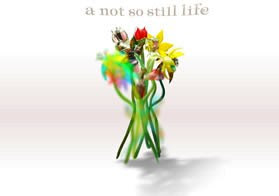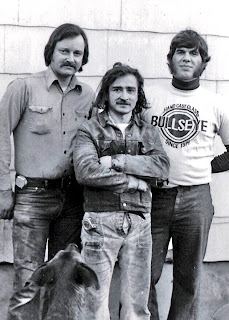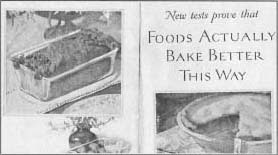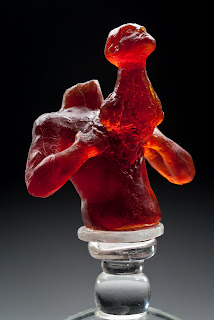>
the shadows that have been seen, cannot be unseen
Using her mind’s eye memory of Punxsutawney Phil, the groundhog in blue is a timely and striking piece.
Phil – considered to be the world’s most famous prognosticating rodent – is supposed to emerge from his home on Gobbler’s Knob, near Punxsutawney, and if he sees his shadow and returns to his hole, he has predicted six more weeks of winter. If Phil does not see his shadow, he has predicted an early spring.
From the 1993 movie “Groundhog Day“
Here’s to the dream of spring!
Melissa Stern KickStarter "Talking Cure"
>Melissa Stern – the mixed media artist that had a residency at the Washington Glass School this past summer has a new project/exhibition that she is seeking support.
The proposed exhibition integrates mixed material sculpture, contemporary literature, and audio technology – titled the “Talking Cure,” . The exhibition is scheduled to open in Seattle in March and in New York City in 2013.
The project title, “The Talking Cure,” takes its name from Sigmund Freud’s original description of psychoanalysis. The exhibition will consist of ten of Melissa’s sculptures each accompanied by an interactive audio track created by a literary collaborator.
Says Melissa: “My sculptures will be fabricated figures combining mixed materials, found objects, deeply drawn surfaces, and an abundance of personality. Seeing and saying, thinking and talking, will cure all your problems!
I have asked ten writers- poets, novelists, screenwriters, and playwrights- to each chose a sculpture to which they relate most intimately. Each is writing his or her imagined monologue of the goings on in the sculpture’s mind. These will then be transformed into audio recordings. A QR tag will accompany each sculpture. When the viewer points a Smartphone, Blackberry or I-Phone reading device at the QR tag it will trigger audio to hear the inner voice of the sculpture.
I have long been fascinated by what goes on in people’s minds when they look at art. What stories do they tell themselves? What emotions and memories are triggered? My work has always been psychological in nature. In the past I have made shows that deal explicitly with memory, childhood and family. By definition these subjects have a strong psychological bent. I am as interested in what others think the pieces are “saying” as in what has motivated me to make them.
In this project we will have a chance to hear what others think goes on in the minds of my sculptural ‘people.‘”
Click HERE to jump to Melissa’s Kickstarter project description.
Kickstarter is an online threshold pledge system for funding creative projects.
Washington Sculptors Group Lecture "The Changing Contemporary Art World"
>Washington Sculptors Group
Talk with Tim Tate: Artist’s Covenants and Social Media
on Wednesday, February 1, 2012 from 6:30pm to 8:30pm
Limited to 35 participants, R.S.V.P. to programs@washingtonsculptors.org
The Washington Sculptors Group presents an informal interactive seminar/discussion with participants interested in new ways to market their art in the 21st century. Tim Tate, a sculptor extraordinaire and Fulbright Scholar, will share a wealth of his experience in building one’s name, market and career within the contemporary art world. Filled with real life examples and possibilities, this workshop may change the way participants see themselves as artists.
Click HERE to jump to East City Art blog for more info
Click here for directions:
http://g.co/maps/zakbg
The Washington Glass School is located at 3700 Otis Street, Mount Rainier, MD 20712. Visit online at http://washingtonglassschool.com/school/
Visit The Washington Sculptors Group online at www.washingtonsculptors.org or call (202) 686-8696
Jack Johnson & Glass
>
This past summer we had a blog posting about National Geographic‘s newly created “Arts Ambassador for the Environment Award” – given to entertainers that are leaders in environmental and cultural conservation. The award was designed and made by the Washington Glass Studio from recycled glass. The winner for the inaugural award was singer Jack Johnson. We just received a photo of Jack holding his award.
Master Class in Painting On Glass
>
Coming soon is the Master Painting on Glass class – make sure you don’t miss the chance to learn from glass guru Bert Weiss!

Master Class: Painting On Glass with Bert Weiss
Instructor: Bert Weiss
Dates: President’s Day Weekend – February 18, 19 & 20th, 2012
Time: 10 am – 4pm each day
Tuition: $400
Led by master artist Bert Weiss, this three-day glass painting technique class features multiple projects designed to give the student a better understanding of lass painting and its enormous potential in fused glass. Bert’s techniques allow you to use vibrant colors without worrying about glass compatibility. The course will show you how to mix metallic oxide colorants with glass and create oil paint like-washes. This course is suitable for all levels of experience. Students do not need to bring anything, all the tools and materials are provided for the course – just wear suitable old clothes and sturdy shoes… oh, and bring a lunch! Bert Weiss studied traditional glass painting with Albinus Elskus and has developed and improved his techniques for the past 40 years. Bring any questions you may have had about glass fusing; within 10 minutes Bert should be able to troubleshoot!
Class 1204 – Master Class: Painting On Glass with Bert Weiss
Instructor: Bert Weiss
Dates: President’s Day Weekend – February 18, 19 & 20th, 2012
Time: 10 am – 4pm each day
Tuition: $400
Click HERE to jump to the WGS class website page.
Compelled by Tim Tate
>
Many in the DC area know the work of sculptor Tim Tate – but I am sure many are not aware of the origins of his imagery and what drives him to make such personal artwork. Recently, Tim met with a museum curator for a show later to be installed this year and Tim outlined his obsessions. It is such a fascinating story – I insisted that the school blog share it with all:
The Foundations of Tim Tate’s Artwork
My art grows out of my life filled with unusual experiences, though it begins simply enough. I grew up in a household filled with art supplies, as my mother was an artist. My original intent as an adolescent was to take ceramics at Cranbrook, but my family could not afford to send me, so I had to settle, making art on the side while beginning a different career path.
Then, as a very young man, I received a terminal diagnosis. I was given less than a year to live, a very difficult concept for a young man to get his head around. I remember that one of my first thoughts was that I was living in someone else’s life. That I was living the life others wanted me to live. I decided at that instant to try to reclaim my artistic side.
With only a year to live, there was no need to apply to grad school….so I discovered the amazing workshops at Penland and threw myself into learning. Yet, at the end of a year, I was surprisingly still alive. They told me I was lucky, but that I should sew up my affairs, as I still had but a year at most. I heard this yearly for the next 10 years.
It’s hard to imagine, I know….to live for over a decade believing I would be struck down at any minute. It changes you and your priorities. Legacy becomes imperative. To be remembered after you are gone. It affected me the most by making sure that every free hour or trip I could spare was to Penland. My entire reason for surviving became the need to master and understand the artistic medium of glass, though I could only afford the 1- or 2-week classes. I lived this way for 10 years.
Then my mother passed away. In her will she left me enough money and instructions to take a concentration class at Penland. Now I had 2 full months to invest towards my work. Prior to this concentration I had completely focused on technique. The class completely changed my life. It focused almost entirely on narrative content. My final piece was a design to hold my mother’s ashes and memories. One of these works went straight to the Renwick Museum. Today it is in the Smithsonian American Art Museum.
So much about glass art at this time was technique driven, but I truly believed it could be so much more. I was determined to have glass taken seriously as a sculptural medium. My work revolved around healing and memory, heaven and hell, nostalgia and resurrection. I began working in the form of reliquaries.
Glass, and Penland, had saved my life to that point. I began seeing each of my pieces as a way to connect to the viewer…to act as a healing agent for them, as well as for me while creating the piece. At first these pieces simply included objects, then they began including text. I also became obsessed with miniaturizing objects. I would make them out of clay, then use lost wax casting to make objects…..hundreds of objects. Each one I made became a language in my image library. Each one carried significance, and by combining them I could produce a dialog. These dialogs became very elaborate, but always with my true themes of healing and memory, heaven and hell, nostalgia and resurrection.
I produced over 100 of these reliquaries….each one healing me just a little bit more. In my mind, each one was truly imbued with existential healing powers not only for myself, but for whoever owned them. I still believe this.
At a certain point I realized that by adding video to my work, my narrative could be exponentially expanded. I became as obsessed with video as I was with glass. Now I could really examine the themes I had become so interested in. I also started realizing that I could leave glass behind. My work separated into two distinct categories. For shows like S.O.F.A. and the material-based galleries that supported it, my work focused heavily on my interest in miniaturization of objects in glass. When I added video, the dialog in these forums was still frequently about the technique used in producing the glass, though the intellectual property had shifted. There will always be a fascination with small glass objects.
In the shows like ArtBasel and its satellite shows, however, as well as the galleries that support them, the dialog completely shifted to the concept behind the piece. This has allowed me to fully expand my specific narrative to video, not always including glass. Now I could expand my work to larger series, and have shows that were solely video. This will be the case in my large museum show next summer.
In all this, my narrative has not changed. Knowing that I am headed to Heaven (or more certainly Hell), I love inventing heaven and hell the way I want to see them. I still am always investigating man’s relationship with healing and reliquary…even when the reliquary takes the form of video. I still work through my own angst about memory and nostalgia, but I broaden it beyond my immediate experience to make it more universal…less specific. Thus my videos may be the most healing of all my work.
You are probably asking what happened to the terminal diagnosis – which was 28 years ago. Well, the diagnosis still stands. But fortunately the doctors were wrong regarding its speed. This helps explain why I’m driven so hard. I always believe I will be struck down suddenly.
My obsession with healing and reliquary continues, even in video form. Hopefully this will give you additional insight into each piece you see. The more a viewer relates to my work, the more successful it becomes to me.
I see my sculptures as self-contained video installations. Blending a traditional craft with new media technology gives me the framework into which I fit my artistic narrative. Revelation — and in some cases self-revelation — is the underlying theme of my electronic reliquaries.
My interactive pieces can be seen as disturbing because the face that stares back from the video screen — your own — prompts a variety of responses: amusement, discomfort, embarrassment, something akin to the feeling you have when someone catches you looking at your own reflection in a store window as you walk by.
But the important revelations here are in the viewer’s response to my hybrid art form and its conceptual nature. I try to bare everything — the guts of my materials and my inner thoughts — in deceptively simple narrative videos set into specimen jars. Nothing is random, all elements are thought out.
To me, these works are phylacteries of sorts, the transparent reliquaries in which bits of saints’ bones or hair — relics — are displayed. In many cultures and religions, relics are believed to have healing powers. My relics are temporal, sounds and moving images formally enshrined, encapsulating experiences like cultural specimens. And perhaps, to the contemporary soul, they are no less reliquaries than those containing the bones of a saint.
Art-o-matic is back for 2012!
>
~~~~~~~~~~~~~~~~~~~~~~~~~~~~~~~~~~~~~~~~~~~~~~~
Artomatic returns to Crystal City in 2012 for our signature free arts event, to be held in the biggest Artomatic building ever, from May 18 – June 24.
Artomatic will partner with the Crystal City Business Improvement District (BID) to transform the Transwestern Presidential Tower at 2511 S. Clark St. in Crystal City into a vibrant arts community that celebrates creativity and creates a unique and exciting event for tens of thousands of visitors – all free to visit.
Registration information to exhibit work at Artomatic will be available soon. To get the latest updates, keep an eye on your email, and subscribe to Artomatic by Facebook, or Twitter.
Ginny Ruffner: A Not So Still Life
>

Save The Date!
February 29, 2012 at noon, the Renwick Gallery of the Smithsonian American Art Museum will screen “Ginny Ruffner: A Not So Still Life.” “A Not So Still Life” peers into the kaleidoscopic mind of American glass artist Ginny Ruffner. The documentary explores Ruffner’s journey from her childhood in South Carolina to her emergence as a world-renowned artist. The film also highlights her influences, including Dale Chihuly, Graham Nash, and Tom Robbins. The film is 80 minutes in length and was directed by Karen Stanton; produced by Shadowcatcher Entertainment/Tom Gorai. The event will take place at the Grand Salon of the Renwick Gallery and admission is free. After the screening, Ginny will participate in a discussion about the film and sign copies of the DVD that will be available for purchase on site.
Glass artist Ginny Ruffner can’t be summed up in one word, but the most commonly used term is “inspiring”. Adding to Ginny’s extraordinary story is her astounding recovery from a near-fatal car accident in 1991 which left her in a coma for five weeks and confined to a hospital for five months. Doctors were convinced that she would never walk or talk again, but true to her indomitable spirit, Ginny Ruffner transformed a potentially tragic accident into a career of even more imaginative creations. From pop-up books, to room-sized installation pieces, to public works, Ginny’s art has blossomed and continues to expand. Ginny Ruffner: A Not So Still Life marks ShadowCatcher Entertainment’s first feature-length documentary, and one sure to challenge you to see the world from a new and unexpected perspective.
Following screening of the film, Maurine Littleton will feature an exhibition of Ginny’s work at the gallery. The gallery event will begin approximately at 2:00 PM and Ginny will be present.
 The Maurine Littleton Gallery is located at 1667 Wisconsin Ave NW, Washington DC.
The Maurine Littleton Gallery is located at 1667 Wisconsin Ave NW, Washington DC.
History of Fused Glass
>
Update: Click Here for Part 1 The Pioneers
Click HERE for Part 2 The 60’s, 70’s & 80’s
2012 is the milestone year for the American Studio Art Glass Movement – taking its start the Toledo workshops with Harvey Littleton & Dominick Labino. I know there are many events planned and stories that will be published this year about how glass moved from the factory into the hands of artists – but for studio glass – usually the focus is on blown glass.
I want to do a blog posting that references the history of warm glass.
Who would you suggest as the fused glass pioneers, superstars & legends? I know of Klaus Moje and Richard La Londe – but who else jumps to mind when mentioning kiln-formed glass?


Personally, I’d prefer suggestions of artists that set the foundation for and outlined the language on which we all build our work upon. Pix, links – all is welcome as suggestions.
You can post ideas here or email me at the glass school: (washglassschool@aol.com)
Thanks! B
Historical Glass Fun Facts : Invention of Pyrex & the Studio Glass Movement
>
From this. . . . . . .. . . . . . . .to this.
“It was all her idea”
The History of Pyrex
Back in the early 1900’s, Corning Glass Works was working on a request from the railroads to produce lantern glass that would not break when the hot glass was struck by rain or snow. In response to this request,
In July 1913, a series of events involving Bessie Littleton, the wife of the company’s newest scientist – Dr Jessie Littleton, forced
• The cooking time was shorter
• The cake did not stick to the glass; it was easy to remove with little adhesion
• The cake was unusually uniform
• The flavor of the cake did not remain in the dish after washing
• She could watch the cake bake and know it was done by looking at the underside.

Mr. Littleton brought his wife’s creation to work the following day. Laboratory researchers inspected the cake, which was a “remarkable uniform shade of brown all over.” The men deemed it delicious and very well baked. (A favorite of any lab conclusion, Ed.) Thus began a two-year process to perfect this new invention. The notion of baking in glass was a whole new concept to the public. In 1915, a wondrous new line of “glass dishes for baking” appeared in the nation’s hardware, department and china stores. On May 18, 1915,
The
Click HERE to jump to the story of Harvey Littleton and his historic workshops that brought glass from the factory to the artists.
Other Glass Fun Facts to know and tell:
Glass Fun Facts: Gaffer/Composer
More Glass Fun Facts: Bullseye Glass
Float Glass Fun Facts
Glass Fun Facts – Shattered Glass Predicts Weather
Why is Glass Transparent?


















